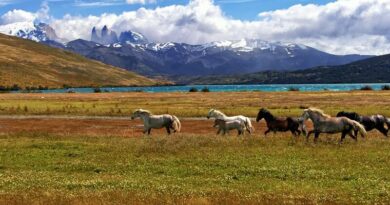The Importance of National Parks
A national park is an area of land or water that is protected for the use of the public and/or the conservation of the environment and wildlife. There are national parks all over the world, approximately 4,000 in total, with the number rising all the time as more and more countries realize the importance of national parks and of conserving areas of natural beauty or ecological importance.
The idea of creating national parks is relatively recent and began when the American government decided that the Niagra Falls needed to be protected before they got destroyed in the 1860s. Other notable national parks include Sagamartha National Park in Nepal, Torres del Paine National Park in Chile, Kruger National Park in South Africa, Tongariro National Park in New Zealand, Galapagos National Park in Ecuador, and the Great Sand Dunes National Park in the USA.
Table of Contents
National park objectives
National parks generally have several objectives. The area should be managed using natural means and this management should contribute to the conservation of species in the area, the area’s ecology, migration routes, etc. The areas are often also used to inspire and educate the public, as well as contributing to the nation’s culture and recreation facilities, but visitor numbers should be closely managed to ensure that no damage is done to the area. If indigenous people are living in the area, these should be supported including by ensuring that they can access resources that they need.
The importance of national parks for the conservation of biodiversity

National parks preserve nature’s great areas of wilderness and are often focused on the preservation of extraordinary areas or symbolic or important species. Preserving biodiversity is complicated by the fact that any change in an area’s ecosystem can have large and unpredictable effects.
For example, in many countries in Europe, the beaver was hunted to extinction and there is now a push to reintroduce beavers into the area because of their important role in river ecosystems. This includes gnawing on stems that provide homes for insects and birds, creating wetlands that provide homes for many animals and which act as sponges, helping the flow of rivers, reducing the risk of flash floods, and retaining water during times of drought. Their dams also capture organic sediments, which reduce the effect of agricultural runoffs. So changes in just one part of an area’s ecosystem can have a range of effects on many other parts.
The importance of national parks in protecting the environment

National parks play an important role in helping to protect the environment. They are generally areas of wilderness that are not interfered with by human activity (beyond efforts necessary to conservation), which means that they do not contribute to the environmental damage caused by humans. Currently, 14.8% of the world’s land is protected, and which does not contribute to environmental damage.
National parks are also a source of sustainable energy. This can include hydropower, wind energy, and solar energy. Many countries are now looking at ways to use national park areas as renewable energy sources in order to reduce the use of fossil fuels and their impact on the environment.
Not only this, but national parks can also directly contribute to reducing the impact of human damage to the environment by storing carbon, and thus reducing the amount of carbon in the atmosphere. Approximately 15% of carbon forest stores are within national parks and protected areas. In countries such as Bolivia, Venezuela, Mexico there are 25 million hectares of forest that store over 4 billion tons of carbon.
As human-caused climate change increases variability in weather systems, the number of natural disasters is increasing. National parks can help to mitigate the impact of natural disasters. Marine protected areas, such as coral reefs and coastal wetlands, protect against natural disasters such as typhoons, hurricanes, and tsunamis. Inland, many national parks contain forested areas, and these can help to protect against natural disasters. For example, forested areas on hillsides can protect against avalanches and the damage caused by earthquakes, saving many lives.
National parks also provide an opportunity for education about the importance of reducing climate change and how to change behavior to do so, with many national parks now providing education programs demonstrating this to the public.
The importance of national parks for the economy

National parks have an impact on both the national economy and local economies. In the US, national parks bring in 300 million visitors per year and it is estimated that for every $1 spent on national parks, there is a return of $10.
National parks are also important for the local rural communities that are near the national parks, known as “gateway communities”. Tourists visiting these areas spend money in hotels, shops, bars, restaurants, etc, and can be a vital source of jobs and income for the local community.
National parks also contribute to the economy by supporting agriculture. In protected marine areas, fish are allowed to breed and grow, and they spill over into the fished areas. This helps to replenish the fished areas, allowing more fish to be caught and sold.
Similarly, in national parks that are inland, the wild relatives of common crops are allowed to thrive. This provides diverse genetic material that can then be used for crop breeding, and to protect against crop damage or failure. Globally, agriculture is a $2.4 trillion dollar industry, so helping to support it is a valuable contribution to many national economies.
Again, on a more local level, many local communities that are located near national parks rely on farming to survive. National parks contribute to these local economies for the reasons listed above, and also through protecting rural areas that may otherwise be developed.
The importance of national parks for health

National parks play an important role in promoting physical and mental health. Visitors to national parks spend their time outside and active, whether it be climbing, hiking, or just walking around. Walking outside can improve lung function, boosts the body’s production of collagen which will help you look younger, increase vitamin D levels which can protect against heart disease, Alzheimer’s disease, and prostate cancer, and can help reduce weight gain. The average distance traveled by foot when visiting a national park is between 1 and 20 miles, so they help to increase exercise levels.
Being outside in nature also has important impacts on mental health. Walking is effective in reducing anxiety and depression. Being in nature activates different areas of the brain, which have a calming effect on the mind and which reduces the heart rate and blood pressure. This also reduces symptoms of stress or anger.
Walking in nature, and especially pursuits such as hiking, contribute to greater self-confidence and self-esteem, which has a big impact on mental wellbeing. For people who suffer from the seasonal affective disorder (SAD), a form of depression that occurs during the winter months, spending time outdoors in nature can help to reduce symptoms because of the increased amount of sunlight and vitamin D (as well as its other effects on depression symptoms).
The importance of national parks for social connections

Visiting a national park in a group, as a family, or with a friend can help to strengthen those social connections and boost relationships. A visit to a national park can be a shared experience of wonder, which allows you to connect to those around you on a deeper level. If you go hiking or another pursuit, this can also encourage team-building and working together, which can also provide a boost to those relationships. Even if you visit national parks alone, this can help you to create connections with other people who have a shared interest with you.
Beyond this, many national parks contain natural sacred sites. For example, Devil’s Tower in Wyoming is a sacred site for a variety of Native American Tribes and Gunlam Falls in Australia is sacred to Aboriginal tribes. In fact, in some countries, nearly all of the national parks contain sacred sites. These sites hold great cultural value and can help to strengthen communities and the bonds between the people within them. They provide places to gather and worship, or to conduct festivals, and helping to care for these sites can provide an opportunity for the community to work together.
Conclusion
The importance of national parks comes in many forms. National parks are important for preserving biodiversity by supporting ecosystems and the flora within them, protecting the environment through providing sustainable energy and mitigating the impact of climate change, and for national and local economies by supporting tourism and protecting agriculture.
They are also important on an individual level for those people who visit the national parks because they can improve physical and mental health, help to strengthen social connections through shared experiences including religious experience, and provide an opportunity for being educated about how to reduce behavior that could contribute to climate change.




